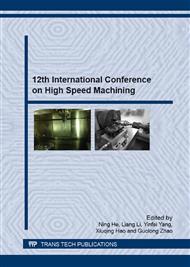p.94
p.99
p.106
p.112
p.117
p.126
p.132
p.139
p.147
Discrete Element Simulation of Machining Cracks in Brittle Materials during High Speed Cutting
Abstract:
The dynamic process of cracks initiation in brittle materials during high speed cutting is primary for the analysis of material fracture mode and finished surface. Cast iron was considered in this paper and discrete element method (DEM) was employed to create a density packed bonded-particle model for studying its machining cracks. The numerical tests of split Hopkinson pressure bar (SHPB) and oblique plane impact were conducted to calibrate the dynamic behaviour of the model. The cutting simulations were carried out for a range of rake angles and cutting speeds. The results showed that both the processes of cracks initiation and the cracks distribution were different greatly under different cutting conditions and the cracks number increased with the cutting speed. In addition, within the detection zone in the model, the duration of crack initiation decreased dramatically with the increase of cutting speed in the lower range. But for the high speed cutting, the duration tended to be stable and was not affected by cutting speed and it was very close to the time of stress wave produced by cutting arriving at the zone. Furthermore, the stress state of particles’ connectors under the action of stress wave was analysed, which suggests that the stress wave is the key factor causing cracks initiation of brittle materials during high speed cutting.
Info:
Periodical:
Pages:
117-125
Citation:
Online since:
January 2016
Authors:
Price:
Сopyright:
© 2016 Trans Tech Publications Ltd. All Rights Reserved
Share:
Citation:


